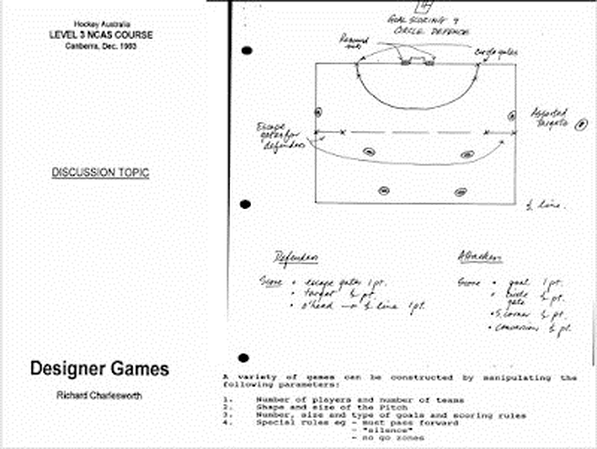By Shane Pill
Associate Professor in Physical Education and Sport at Flinders University, Australia
Website: https://www.flinders.edu.au/people/shane.pill
Twitter: @pilly66
Linkedin: https://www.linkedin.com/in/shane-pill-phd-med-bed-lmachper-fachper-53a3b528/
Orcid: https://orcid.org/0000-0003-3970-6724
Blog: http://learningthroughsport.blogspot.com.au/
Associate Professor in Physical Education and Sport at Flinders University, Australia
Website: https://www.flinders.edu.au/people/shane.pill
Twitter: @pilly66
Linkedin: https://www.linkedin.com/in/shane-pill-phd-med-bed-lmachper-fachper-53a3b528/
Orcid: https://orcid.org/0000-0003-3970-6724
Blog: http://learningthroughsport.blogspot.com.au/
Introduction
To celebrate the 40th anniversary of the Teaching Games for Understanding (TGfU) model, there will be a monthly ‘spotlight’ focus on key models/approaches with the field of Games-Based Approaches (GBAs). To start I would like to provide an outline of Designer Games by Rick Charlesworth.
Possibly Australia's most successful international team sport coach, Rick Charlesworth https://en.wikipedia.org/wiki/Ric_Charlesworth , promoted the use of modified and small sided ‘designer games’ for a coach to achieve fitness objectives at the same time as pursuing technical and tactical training objectives through the employment of game play, rather than fragmenting training sessions into separate technical, tactical and fitness training segments (1993, 1994).
To celebrate the 40th anniversary of the Teaching Games for Understanding (TGfU) model, there will be a monthly ‘spotlight’ focus on key models/approaches with the field of Games-Based Approaches (GBAs). To start I would like to provide an outline of Designer Games by Rick Charlesworth.
Possibly Australia's most successful international team sport coach, Rick Charlesworth https://en.wikipedia.org/wiki/Ric_Charlesworth , promoted the use of modified and small sided ‘designer games’ for a coach to achieve fitness objectives at the same time as pursuing technical and tactical training objectives through the employment of game play, rather than fragmenting training sessions into separate technical, tactical and fitness training segments (1993, 1994).
A designer game “is a contest between teams in which a result (win/lose) is sought. The teams must strive to win while the game and design allows particular emphasis on aspects of hockey-craft in that particular environment” (Charlesworth, 1993). A designer game is constructed by manipulating “game parameters” (Charlesworth, 1993) such as: number of players; shape and size of pitch, scoring rules, size and number of goals, special rules (e.g., ‘no go zones’).
Specific emphasis in designer games included Transition and Playreading.
On transition: “In my view, perhaps the most critical aspect of real game situations is best catered for in competitive designer games as play doesn't stop until a goal is scored. In too many artificial training drills there is "a relaxation phase" not found in the competitive game. The metamorphosis from defender to attacker and back again is continuous and unrelenting and can not be given enough emphasis”
On playreading: “It is interesting to stop the game and ask teams what is going on. Often I will instruct one team to play a particular way and wait to see how long their opponents take to work out what is happening. Such questioning stimulates players to be more analytical during the game”
(Charlesworth, 1994, p. 32).
A designer game is meant to “provide a competitive, strategic, distracted, “decision-laden” environment” (Charlesworth, 1993, p. 33) to players.
We would like to encourage you to continue supporting the 40th Anniversary of TGfU celebrations; including our next instalment in the special blogs where we will be discussing more limited visibility and/or country-specific models/approaches. Please visit http://www.tgfu.info/40th-anniversary.html for our other events.
Specific emphasis in designer games included Transition and Playreading.
On transition: “In my view, perhaps the most critical aspect of real game situations is best catered for in competitive designer games as play doesn't stop until a goal is scored. In too many artificial training drills there is "a relaxation phase" not found in the competitive game. The metamorphosis from defender to attacker and back again is continuous and unrelenting and can not be given enough emphasis”
On playreading: “It is interesting to stop the game and ask teams what is going on. Often I will instruct one team to play a particular way and wait to see how long their opponents take to work out what is happening. Such questioning stimulates players to be more analytical during the game”
(Charlesworth, 1994, p. 32).
A designer game is meant to “provide a competitive, strategic, distracted, “decision-laden” environment” (Charlesworth, 1993, p. 33) to players.
We would like to encourage you to continue supporting the 40th Anniversary of TGfU celebrations; including our next instalment in the special blogs where we will be discussing more limited visibility and/or country-specific models/approaches. Please visit http://www.tgfu.info/40th-anniversary.html for our other events.
References
Charlesworth, R. (1993). Hockey Australia Level 3 NCAS Course: Discussion topic – Designer Games. Canberra, December.
Charlesworth, R. (1994). Designer games. Sports Coach, 17(4), 30-33.
Charlesworth, R. (1993). Hockey Australia Level 3 NCAS Course: Discussion topic – Designer Games. Canberra, December.
Charlesworth, R. (1994). Designer games. Sports Coach, 17(4), 30-33.


 RSS Feed
RSS Feed
